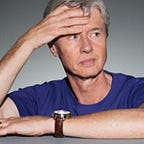Don’t just see Cartier-Bresson in terms of ‘decisive moments’. At bottom he was a psychological photographer.
Is there anything left to say about Henri Cartier-Bresson (“HCB”) that has not already been said? Perhaps not. A Google search of his name returns more than 5 million results in half a second. But I can’t help feeling that there is more to be said, especially after reading a review by Sean O’Hagan on the re-issue of the book, ‘Decisive Moment’. I have been looking at HCB’s photographs since my Dad introduced them to me in the early 1960s and still now, after 50 years, they demand attention in a way that O’Hagan doesn’t seem to understand.
We may quietly agree with Gaby Wood when she writes, “The reason his photographs often feel numbly impersonal now is not just that they are familiar. It’s that they’re so coolly composed, so infernally correct that there’s nothing raw about them, and you find yourself thinking: would it not be more interesting if his moments were a little less decisive?” But Wood and O’Hagan, to name just two from countless many, make too much of this ‘decisive moment’. “It cements an idea of photography that is no longer current but continues to exist as an unquestioned yardstick in the public eye: black and white, acutely observational, meticulously composed, charming”, continues O’Hagan.
But we have to look beyond picking off ‘black and white, acutely observational, meticulously composed’ features to really appreciate HCB. The thing about many HCB pictures is that it’s the totality of expression that gives them an extraordinary hold on us. As HCB recognised:
“In a photograph, composition is the result of a simultaneous coalition, the organic coordination of elements seen by the eye. One does not add composition as though it were an afterthought superimposed on the basic subject material, since it is impossible to separate content from form. Composition must have its own inevitability about it” .
The composition provides a door through which vision is intensified, perhaps a door into the “optical unconscious” transporting us from daily clock time into internal (Bergsonian) time. It is interesting that Cartier-Bresson referred to André Breton’s idea in L’Amour Fou, that there is a continuous inter-play between our unconscious and what we see and that we see “coincidences” when the unconscious is made to work. [Cartier-Bresson, L’imaginaire d’apres nature, Cognac: Fata Morgana; 1996] This surreal quality is evident in this photograph, reminding us perhaps of 1 Corinthians 13–12 … ‘for now we see through a glass, darkly, but then face to face. Now I know in part; but then shall I know, even as also I am known’:
The power of HCB to induce both reflectivity and reflexivity is evident. Perhaps Kant came closer than anyone to understanding the transcendental principles involved in apprehending not just perceptual shapes but that which represents a purposiveness in ‘the form of a thing’ [Kant, Critique of Judgement, Intro. v111, 31] as non-conceptual, but it is to Merleau-Ponty that we turn to the idea that we are deeply ‘intermingled’ with objects …“Perception … is the background from which all acts stand out, and is presupposed by them.” [Merleau-Ponty, ‘Phenomenology of Perception’, x–xi]
We walk through life comfortable with the every-day and familiar. Conscious awareness acts as a backlighting for life’s concrete experiences and events. However, as Merleau-Ponty reminds us … “perception hides itself from itself… it is of the essence of (awareness) to forget its own phenomena thus enabling ‘things’ to be constituted,” [Merleau-Ponty, Phenomenology of Perception P. 58]. Because of some incongruity in the world’s usualness, we bring direct awareness to the unusualness, when prompted. Our perceptual cognition moves to the foreground because we are surprised and not exactly sure what we see. The always-already perceptual field is called into question and we must give attention to what otherwise we would not need to. Merleau-Ponty: “(it) slackens the intentional threads which attach us to the world and thus brings them to our notice….” [ Merleau-Ponty, Phenomenology of Perception, xiii].
It is this ‘prompting’ that is so evident in HCB’s photographs.
Take HCB’s photograph of the Village of Aquila, Abruzzi below. In this complex picture we have strong diagonals that transport attention backwards into the picture and forwards to the foreground; we have in the foreground the gestalt principle of similarity in the pairs of people; we have distinctive figure/ground relationships throughout the picture; we have the internal framing effects of the railings dividing the picture up into comprehensible units; we have the overall framing that includes the words ‘ORA PRO NOBIS’ (‘pray for us’). Despite its complexity, we take the scene in immediately. The whole is other than the sum of its parts — a thought embodied in perceptual form — and the thought for me is one of bondage and the inevitability in the lives of these people. [See David Davies — “How Photographs Signify”, in ‘Photography and Philosophy — Essays on the Pencil of Nature; edited by Scott Walden, 2010]
We can miss much in HCB by overly fussing over ‘decisive moments’. To be sure, every cliché has a kernel of truth, but what makes HCB so fascinating is the psychological depths invoked by his mastery of pulling together form and content in a way that prompts attention — the geometry of his work. ‘Decisive Moments’ are only a part of the HCB story. Of course, as O’Hagan says, Frank, Eggleston, Meyerowitz and Winogrand took street photography into new pastures, but it is wrong to say that … ‘(Cartier-Bresson) cements an idea of photography that is no longer current’. O’Hagan misses the point about HCB. His pictures have the power to complete us.
